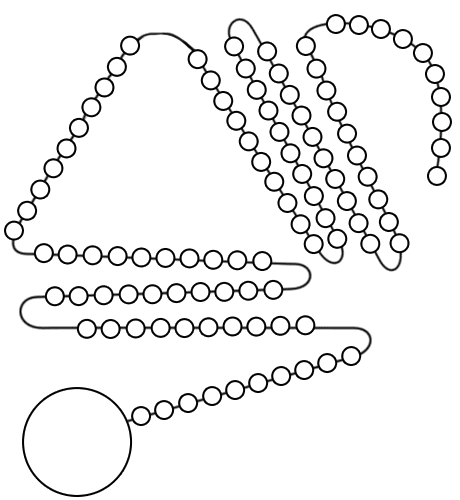
When I first read Chapter 5 of The Absorbent Mind, The Miracle of Creation, I found myself thinking of the scientific advances that have happened since Montessori’s time.
Studying the Works of Montessori - The Absorbent Mind, Chapter 4: The New Path
I admit, I began skimming the first part of the chapter that discusses conception, cell division, and heredity. Then, I saw the illustration on page 37 and thought, “That’s a Golden Bead 100-chain.” Intrigued, I went back to read how the illustration fit into the idea of individual creation.
 |
| A chain of 100 genes pictured as a line (Montessori, 1964) |
While talking about chromosomes and genes, Montessori purposely used an illustration that we are familiar with, the 100-bead chain, to help us connect new knowledge to something that we already know. This is seen again and again throughout the Montessori curriculum. By beginning with what is known and moving to the unknown, the student, no matter her age, makes connections that lead to that “A ha!” or “Wow!” moment when she discovers something new.
I had another “A ha!” moment later in the chapter where Dr. Montessori discusses how specialized cells make up each organ and how each organ, while having its own unique function, must work together as a whole community to ensure the survival of the organism. She then goes on to create an elaborate metaphor comparing this complex two-system organism to a river and a control-room or command center. In her metaphor, the river carries and collects nourishment to the organism and the command center transmits data to various parts of the organism. (Montessori, 1964) I instantly recognized this detailed metaphor as Montessori’s impressionistic “Great River” lesson. In the impressionistic lesson, the river is blood, which carries nourishment to every cell while also carrying away impurities. The command center is the central nervous system, which controls our every move.
While there has been and continues to be amazing human biological and genetic discoveries since Dr. Montessori’s time, the ease with which she makes this information understandable to even young children continues to amaze me. The 100-bead chain is a sensorial and impressionistic way to help children understand the path of genetic material and the Great River metaphor helps children understand the complexity of the hidden organ systems within the human body. While science continues to discover, Montessori’s lessons stand that test of time.

“…if we remember that all this comes from a single cell, the primitive round germinal cell, then we feel upon us the spell of the wonder and majesty of nature.” — Maria Montessori, The Absorbent Mind, p. 46.
Work Cited
Montessori, Maria. The Absorbent Mind. Wheaton, IL: Theosophical Press, 1964.
As much as possible, NAMC’s web blog reflects the Montessori curriculum as provided in its teacher training programs. We realize and respect that Montessori schools are unique and may vary their schedules and offerings in accordance with the needs of their individual communities. We hope that our readers will find our articles useful and inspiring as a contribution to the global Montessori community.
© North American Montessori Center - originally posted in its entirety at Montessori Teacher Training on Tuesday, February 25, 2014.
© North American Montessori Center - originally posted in its entirety at Montessori Teacher Training on Tuesday, February 25, 2014.


0 comments:
Post a Comment
Have questions or comments? Let us know what you thought about this article!
We appreciate feedback and love to discuss with our readers further.